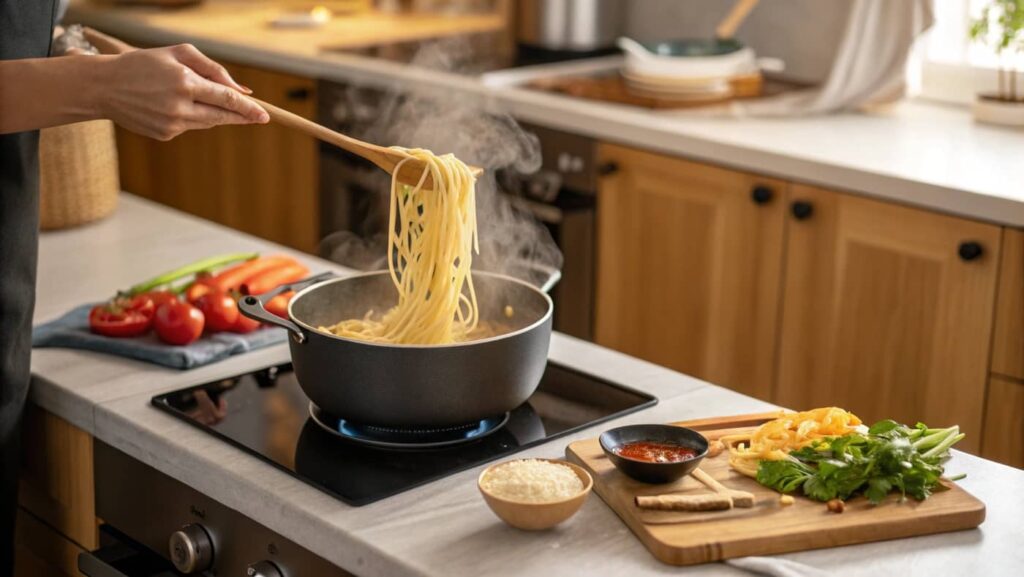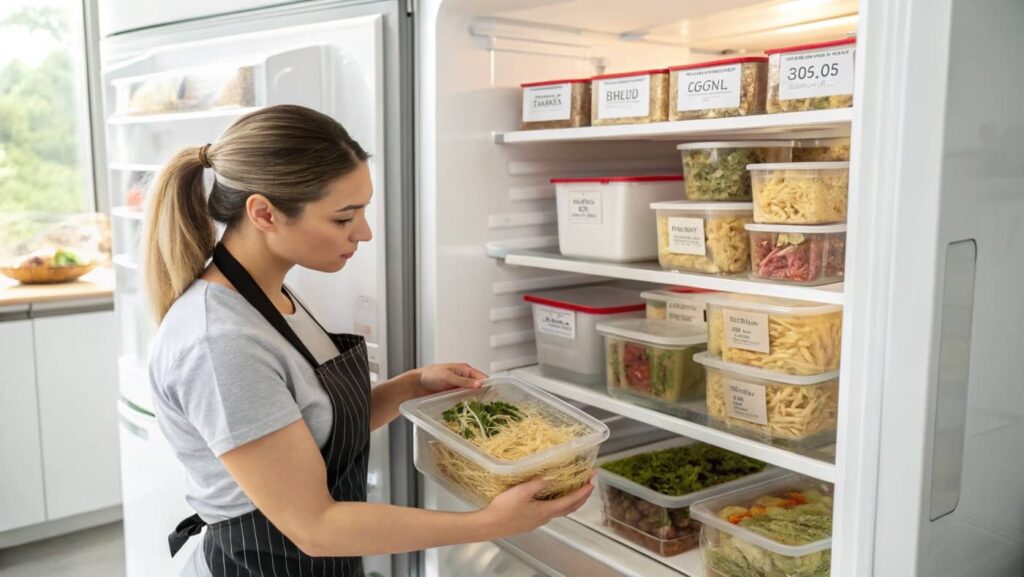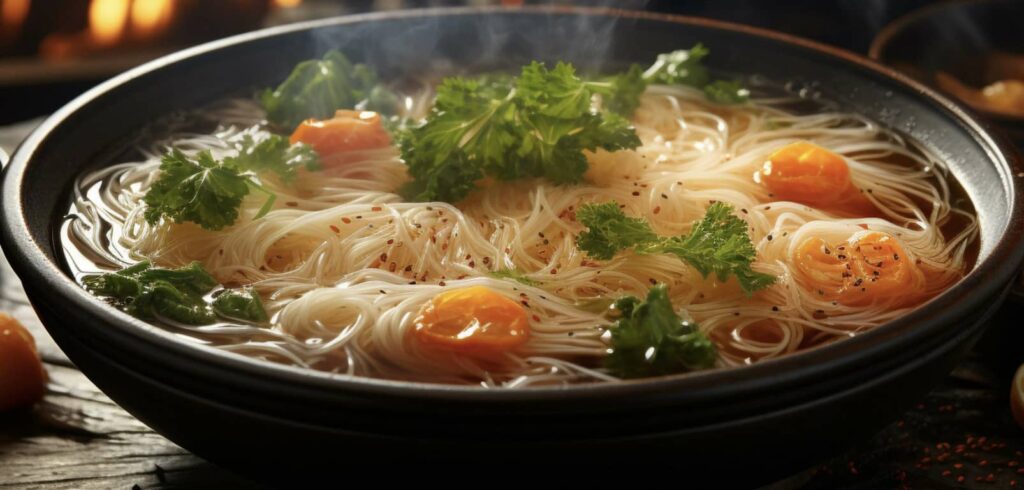What’s the first thing that comes to your mind when you think of comfort food? 🍜 For many, it’s a steaming bowl of noodles. These humble strands have traveled across the globe, charming every culture they’ve touched. But what makes noodles so universally loved? Let’s dive into their delicious world and uncover the secrets behind their popularity!
Table of contents
“Noodles are like the best friend you didn’t know you needed — versatile, comforting, and always there for you when you’re hungry.”
From slurping ramen in Japan to twirling spaghetti in Italy, noodles have carved out a place in nearly every cuisine. But there’s more to noodles than meets the eye. Did you know there are hundreds of varieties, each with its own story?
Types of Noodles Around the World
Asian Noodles: From Ramen to Rice Noodles
Asian cuisine offers an endless array of noodle types. Let’s start with the ever-famous ramen, which comes in various styles like shoyu (soy sauce-based) or tonkotsu (pork bone broth). Then, there’s udon, thick wheat noodles, perfect for soaking up hearty broths. Don’t forget about soba, made from buckwheat, which offers a nutty flavor and is often served cold. And for gluten-free options? Rice noodles like pho or pad Thai noodles have you covered.
Western Noodles: Pasta Varieties and Beyond
When you think of Western noodles, pasta instantly comes to mind. Spaghetti, penne, fettuccine — the list goes on. Each shape serves a purpose: spaghetti for creamy sauces, penne for chunky tomato sauces, and fettuccine for rich Alfredo. But did you know gnocchi (technically a dumpling) and spaetzle also fall into this category? The possibilities are endless.
Gluten-Free and Vegan Noodle Options
Dietary restrictions don’t mean you have to give up noodles! Enter gluten-free rice noodles, chickpea-based pasta, and spiralized veggie noodles like zucchini or carrot. These alternatives are not only healthy but also surprisingly delicious. Whether you’re avoiding gluten or sticking to a plant-based diet, there’s something for everyone.
Table: Popular Noodles and Their Characteristics
| Type of Noodle | Origin | Characteristics |
|---|---|---|
| Ramen | Japan | Wheat-based, thin, chewy |
| Udon | Japan | Thick, soft, wheat-based |
| Spaghetti | Italy | Thin, cylindrical, durum wheat |
| Rice Noodles | China/Southeast Asia | Gluten-free, translucent |
| Zucchini Noodles | Modern/Global | Low-carb, spiralized |
Common Problems When Cooking Noodles
Why Do Noodles Stick Together? Solutions to the Sticky Problem
Ever drained your noodles only to find them clumping together in one big sticky mess? 😩 Don’t worry; we’ve all been there. This happens when starches on the noodle surface gelatinize and act like glue. But how do you fix it?
- Solution 1: Add oil to the boiling water. A teaspoon of olive oil can work wonders!
- Solution 2: Stir your noodles frequently while they’re cooking. The movement keeps them apart.
- Solution 3: Rinse cooked noodles in cold water, especially if you’re using them for cold dishes like salads or stir-fries.
“A little oil and a lot of stirring are your best friends when it comes to non-sticky noodles.”
Overcooked Noodles: How to Avoid a Mushy Disaster
Overcooking noodles is like overwatering a plant — it’s easy to do but hard to reverse. Overcooked noodles turn mushy and lose their chewiness. Here’s how to dodge this kitchen disaster:
- Tip 1: Always check the cooking time on the package, but start testing your noodles a minute or two early.
- Tip 2: Shock cooked noodles in ice water to stop the cooking process immediately.
- Tip 3: If you’ve overcooked them slightly, toss them in a hot pan with some sauce. The texture can improve slightly this way.
Undercooked Noodles: Troubleshooting Tips
Did your noodles turn out too firm or crunchy? Undercooked noodles can ruin your dish, but fixing them is easier than you think:
- Option 1: Return them to the pot with boiling water and cook for another 1-2 minutes.
- Option 2: Add a bit of water to your sauce and simmer the noodles in it until tender.
Remember, practice makes perfect. It might take a few tries, but you’ll soon find your noodle-cooking groove!
Cooking Noodles Like a Pro
How to Cook Noodles Perfectly Every Time

So, how do you achieve noodle nirvana? The key lies in timing, water temperature, and attention. Here’s a simple step-by-step guide:
- Step 1: Bring a large pot of water to a rolling boil. Add a generous pinch of salt to enhance the noodle’s flavor.
- Step 2: Add the noodles, stirring immediately to prevent sticking.
- Step 3: Follow the cooking time on the package but keep testing for your desired doneness.
- Step 4: Drain the noodles but save a cup of the starchy cooking water — it’s a secret weapon for your sauces!
The Secret to Al Dente Noodles
“Al dente” means “to the tooth” in Italian, and it’s the ideal texture for most noodles — firm, but not crunchy. The trick is to undercook your noodles by about a minute and let them finish cooking in the sauce.
“Al dente noodles are like a perfectly tuned guitar string — just the right amount of tension for a satisfying bite.”
Cold Noodles: Techniques for Summer Favorites
There’s something magical about a refreshing bowl of cold noodles on a hot day. Whether it’s Japanese somen or Korean naengmyeon, cold noodles require a slightly different approach:
- Tip 1: Rinse the cooked noodles thoroughly in cold water to stop the cooking process and remove excess starch.
- Tip 2: Toss the noodles with a bit of sesame oil to prevent sticking.
- Tip 3: Serve with chilled toppings and dressings for maximum refreshment.
Table: Common Noodle Cooking Mistakes and Solutions
| Problem | Cause | Solution |
|---|---|---|
| Sticky Noodles | Not enough stirring or oil | Add oil, stir frequently, rinse in cold water |
| Mushy Noodles | Overcooking | Shock in ice water, test doneness early |
| Undercooked Noodles | Removed too soon | Simmer longer or finish in sauce |
Noodle Recipes to Try at Home
Quick and Easy Ramen Recipes
Ramen doesn’t have to be just an instant meal — it can be a full-blown culinary experience! 🌟 Here’s a simple recipe to take your ramen game to the next level:
Spicy Miso Ramen Recipe
| Ingredient | Quantity |
|---|---|
| Ramen noodles | 1 pack |
| Miso paste | 2 tablespoons |
| Chicken or vegetable broth | 2 cups |
| Garlic (minced) | 1 clove |
| Chili oil | 1 teaspoon |
| Boiled egg | 1 (halved) |
| Green onions | For garnish |
- Boil the ramen noodles according to the package instructions and set them aside.
- In a pot, heat the broth and stir in the miso paste until dissolved.
- Add garlic and chili oil for an extra kick of flavor.
- Pour the broth over the noodles and top with a boiled egg and green onions. Enjoy! 🍜
Classic Italian Pasta Dishes
What’s more comforting than a hearty Italian pasta dish? Let’s whip up a creamy Fettuccine Alfredo that’s perfect for any day of the week.
- Pro Tip: Use fresh Parmesan for the best flavor and a velvety texture.
Creative Ways to Use Leftover Noodles
Got leftover noodles? Don’t let them go to waste! Here are some fun and creative ideas:
- Stir-fry: Toss your noodles with soy sauce, vegetables, and a protein of your choice for a quick meal.
- Noodle Omelette: Mix noodles with eggs, pour into a pan, and cook until golden.
- Noodle Salad: Add fresh veggies, a tangy dressing, and some crunchy toppings for a refreshing dish.
Storing and Reheating Noodles
The Best Way to Store Cooked Noodles

If you’ve cooked too many noodles, don’t worry — storing them properly ensures they’ll stay fresh and ready to use:
- Step 1: Toss the noodles with a small amount of oil to prevent sticking.
- Step 2: Store them in an airtight container in the refrigerator for up to 3 days.
Reheating Tips: How to Bring Noodles Back to Life
Reheating noodles can be tricky, but these methods will help keep them as good as new:
- Microwave: Add a splash of water to the container and cover it before microwaving.
- Stovetop: Toss the noodles in a hot pan with a bit of oil or sauce until warmed through.
Healthier Noodle Options
Whole Wheat vs. Regular Noodles: What to Choose?
If you’re trying to make healthier choices, whole wheat noodles are a great option. They’re higher in fiber and nutrients compared to regular noodles, which are made with refined flour. Plus, they have a nutty flavor that pairs well with hearty sauces.
Low-Carb and Keto Noodle Alternatives
For those on a low-carb or keto diet, traditional noodles might not fit the bill. But don’t worry — alternatives like zucchini noodles, shirataki noodles, and spaghetti squash offer a guilt-free way to enjoy your favorite dishes.
Exploring Noodle Varieties Around the World
Asian Noodle Varieties
Asia is home to some of the most iconic noodle dishes in the world. Here’s a look at a few popular types of noodles and their unique characteristics:
- Ramen: Thin, curly wheat noodles served in a rich, savory broth. Perfect for comfort food lovers!
- Udon: Thick, chewy wheat noodles often paired with mild broths or stir-fried with vegetables and soy sauce.
- Rice Noodles: Made from rice flour, these noodles are light, gluten-free, and versatile in dishes like pad thai and pho.
- Soba: Nutty, buckwheat noodles from Japan, delicious served hot in broth or chilled with dipping sauce.
- Glass Noodles: Transparent noodles made from mung bean or potato starch, often found in salads or stir-fries.
European Pasta Staples
While noodles are often associated with Asia, Europe has its own impressive lineup of pasta varieties. 🍝
- Spaghetti: Long, thin noodles perfect for classic dishes like spaghetti Bolognese or carbonara.
- Fettuccine: Flat, ribbon-like noodles often paired with creamy sauces like Alfredo.
- Penne: Tube-shaped pasta ideal for baked dishes and hearty, chunky sauces.
- Lasagna Sheets: Wide, flat noodles used to layer delicious baked casseroles.
- Orzo: Small, rice-shaped pasta often used in soups and salads.
“From the delicate rice noodles of Vietnam to the hearty lasagna sheets of Italy, every culture has its own noodle story to tell.”
Noodles in African and Middle Eastern Cuisine
While less commonly associated with noodles, African and Middle Eastern cuisines have their own take:
- Couscous: While technically pasta, these tiny pearls are often steamed and served with stews in North African dishes.
- Vermicelli: Used in sweet dishes like sheer khurma (a festive dessert) or savory preparations like pilafs.
Fusion Noodles: A Modern Twist
The rise of global fusion cuisine has brought about creative takes on noodles:
- Korean-Italian Fusion: Think bulgogi pasta or kimchi carbonara — the best of both worlds!
- Tex-Mex Noodle Bowls: Spicy taco-seasoned noodles topped with guacamole and salsa.
- Thai Curry Pasta: Fettuccine tossed in a creamy Thai red curry sauce for a spicy, bold flavor.
Noodles as a Symbol of Culture
Noodles and Longevity in Chinese Culture

In Chinese tradition, noodles symbolize longevity and are a must-have dish during birthdays and celebrations. The longer the noodle, the longer the life! Cutting noodles is often avoided, as it’s believed to shorten one’s lifespan. 🥢
Festive Uses of Noodles Around the World
Noodles often take center stage in festive meals:
- Diwali: Sweet vermicelli desserts are a highlight of the Indian festival of lights.
- New Year’s Eve: In Japan, toshikoshi soba is eaten to bid farewell to the old year and welcome the new one.
- Thanksgiving: Creative noodle dishes like mac and cheese often make their way onto American holiday tables.
The Future of Noodles
Sustainable and Innovative Noodles
The food industry is constantly evolving, and noodles are no exception. 🌱 New trends include:
- Plant-Based Noodles: Made from lentils, chickpeas, or edamame for a protein-packed option.
- 3D-Printed Pasta: Yes, you read that right! 3D printing technology is being used to create intricate noodle shapes.
- Low-Waste Production: Brands are exploring ways to reduce water and energy use during noodle manufacturing.
With so many exciting developments, the humble noodle is set to remain a global favorite for generations to come.
Fun Facts About Noodles
Noodles in Pop Culture and History
Did you know noodles have been around for over 4,000 years? The oldest evidence of noodles was found in China, dating back to the Han Dynasty. Today, noodles are a staple in pop culture, appearing in movies, TV shows, and even memes. 🍜
The World’s Longest Noodle: A Record-Breaking Dish
In 2017, a team in China created the world’s longest noodle, measuring an incredible 3,084 meters (over 10,000 feet)! Talk about going the extra mile. 😄
FAQs related to noodles:
- What’s the best way to prevent noodles from sticking together?
To prevent noodles from sticking, stir them frequently while boiling, add a teaspoon of oil to the water, and rinse them under cold water after cooking if you’re not serving them immediately. - How do I know when my noodles are perfectly cooked?
Test your noodles a minute or two before the package cooking time ends. They should be firm but not crunchy (al dente). - Can I freeze cooked noodles?
Yes! Toss the cooked noodles with a bit of oil, place them in an airtight container or freezer bag, and freeze for up to 2 months. Thaw in the fridge before reheating. - What’s the healthiest type of noodles?
Whole wheat noodles are high in fiber, while alternatives like zucchini noodles, shirataki noodles, and chickpea pasta are great low-carb or gluten-free options. - Why do my noodles turn mushy?
Noodles become mushy if overcooked or left soaking in water. Always follow the cooking time on the package and drain them promptly. - Can I reuse noodle water for cooking?
Absolutely! Noodle water is rich in starch and can be added to sauces for extra creaminess and flavor.
Conclusion
So, whether you’re twirling spaghetti, slurping ramen, or experimenting with zucchini noodles, there’s no denying that noodles are one of the most versatile and beloved foods in the world. Go ahead, grab a pot, and start creating your noodle masterpiece today!

